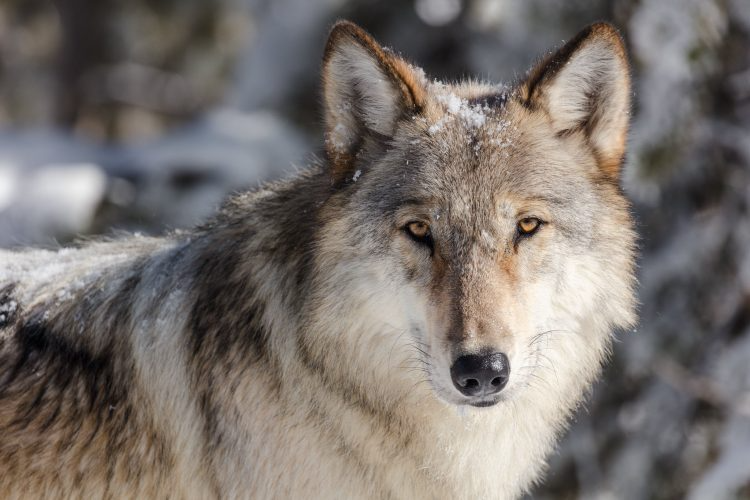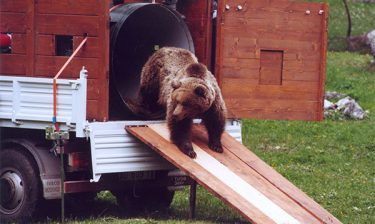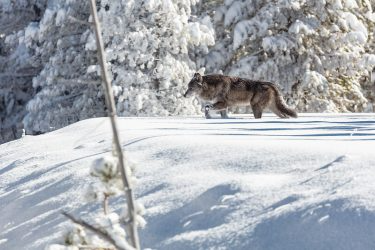Q&A: Bringing A Justice Lens To Wildlife Management
Almost all of the world’s 31 largest carnivore species, including gray wolves, grizzly bears, cheetahs and lions, have been impacted by human development and activity.
 A wolf seen in Yellowstone National Park in 2017. The reintroduction of these large carnivores to the park happened in 1995 and has been hugely divisive ever since.Jacob W. Frank/National Park Service Almost all of the world’s 31 largest carnivore species, including gray wolves, grizzly bears, cheetahs and lions, have been impacted by human development and activity. Most of these animals have seen their range and populations decline over the past century, and many are listed as threatened by international conservation groups.
A wolf seen in Yellowstone National Park in 2017. The reintroduction of these large carnivores to the park happened in 1995 and has been hugely divisive ever since.Jacob W. Frank/National Park Service Almost all of the world’s 31 largest carnivore species, including gray wolves, grizzly bears, cheetahs and lions, have been impacted by human development and activity. Most of these animals have seen their range and populations decline over the past century, and many are listed as threatened by international conservation groups.
As conservationists and scientists consider if and how to bring back these species in significant numbers across their historical ranges, many potential conflicts arise: Will the animals pose a threat to humans or livestock? Who gets to make the decisions? Who benefits the most from these recovery efforts?
A team of researchers led by the University of Washington is considering these questions through an unconventional lens: justice. The researchers drew upon the field of environmental justice — which primarily has focused on harms to people and public health — and applied its concepts to wildlife management, considering forms of injustice that people, communities and animal groups might experience. Environmental justice, in this context, looks at who is most vulnerable and who could be disproportionally harmed by large carnivore reintroductions.
“We are awakening to the fact that justice matters and is present in a lot of domains, including conservation projects,” said lead author Alex McInturff, an assistant professor in the UW School of Environmental and Forest Sciences. “We’re hoping this paper is a really timely intervention that gives those involved in these reintroduction projects a framework to say, ‘We care about justice. We didn’t really know we were overlooking it in past efforts, and now we have something that can help inform us going forward.’”
The team published its framework last month in the journal Elementa: Science of the Anthropocene. UW News spoke with McInturff to find out more about the team’s goals for this work.
UW News: How can environmental justice help with wildlife conservation?
AM: Environmental justice and biodiversity conservation are two of the most important concerns people and nature face in the 21st century, but they’re rarely discussed together. Now, there is an emerging paradigm in conservation that asks, how can humans coexist with free-living animals — even ones that are potentially dangerous like large carnivores — instead of thinking about conservation only as setting aside protected land for species? As we begin this new paradigm in conservation, we propose starting it with questions of justice in mind so that they’re baked in from the beginning.
The bear pictured here, nicknamed “Daniza,” was one of nine bears reintroduced to Italy from Slovenia between 1999 and 2001.Archivio Parco Naturale Adamello Brenta
What unique challenges do large carnivore reintroductions pose that environmental justice can help address?
 The bear pictured here, nicknamed “Daniza,” was one of nine bears reintroduced to Italy from Slovenia between 1999 and 2001.Archivio Parco Naturale Adamello Brenta Large carnivores are a unique set of species for a lot of different reasons. They are involved in just about every kind of human-animal conflict you can imagine, so we thought they were a challenging but important place to start. Some of these challenges: People who make decisions about carnivore reintroductions sometimes don’t live near the places where the recovery efforts — and potential related animal-human conflicts — are occurring. Large carnivores themselves are wide-ranging and highly mobile. One animal’s erratic behavior can impact people’s view of the entire species. So, the challenges and the opportunities go hand in hand, and that makes this difficult, but also important, to tackle.
The bear pictured here, nicknamed “Daniza,” was one of nine bears reintroduced to Italy from Slovenia between 1999 and 2001.Archivio Parco Naturale Adamello Brenta Large carnivores are a unique set of species for a lot of different reasons. They are involved in just about every kind of human-animal conflict you can imagine, so we thought they were a challenging but important place to start. Some of these challenges: People who make decisions about carnivore reintroductions sometimes don’t live near the places where the recovery efforts — and potential related animal-human conflicts — are occurring. Large carnivores themselves are wide-ranging and highly mobile. One animal’s erratic behavior can impact people’s view of the entire species. So, the challenges and the opportunities go hand in hand, and that makes this difficult, but also important, to tackle.
In the paper, you describe four components of environmental justice that are important to consider in conservation projects. Can you explain those in the context of large carnivore reintroductions?
Distribution considers who is actually being harmed materially and who is benefiting
Participation asks who has a seat at the decision-making table
Recognition asks whose worldview is being recognized in the terms of the debate or in the discussion itself
And finally, affective (or emotional) justice considers how we appropriately account for people’s emotions — fear, anger, happiness, for example — toward the reintroduction of certain species
 A wolf moves through fresh snow in Yellowstone National Park, 2017.Jacob W. Frank/National Park Service On this last point: On one hand, we should take emotions really seriously — fear can be life-changing and is very important to understand as a harm in and of itself. And at the same time, emotions can be difficult to estimate, and they can reorient power dynamics. In the case of large carnivores, we’ve often seen people who are not vulnerable or marginalized use emotions like fear to make themselves into victims. They wind up having an even bigger voice in the decision-making process than they might have had before.
A wolf moves through fresh snow in Yellowstone National Park, 2017.Jacob W. Frank/National Park Service On this last point: On one hand, we should take emotions really seriously — fear can be life-changing and is very important to understand as a harm in and of itself. And at the same time, emotions can be difficult to estimate, and they can reorient power dynamics. In the case of large carnivores, we’ve often seen people who are not vulnerable or marginalized use emotions like fear to make themselves into victims. They wind up having an even bigger voice in the decision-making process than they might have had before.
So how can we use this environmental justice framework going forward in these reintroduction efforts?
A wolf moves through fresh snow in Yellowstone National Park, 2017.Jacob W. Frank/National Park Service
Through a justice lens, we can ask questions about who is making decisions, and whether they are people who are in power, or people who are already marginalized. We can try to measure the ways in which material harm has been inflicted on different groups of people, or the ways in which impacts are unequally distributed. Social science, or humanistic, considerations tell us a bit about the bigger picture: What are the worldviews involved, how might those limit or enable discussions that weren’t possible before, and how are people’s emotional experiences shaping these conversations and the possible outcomes?
The reintroduction of wolves to Yellowstone National Park happened in 1995 and has been hugely divisive ever since. People have spent millions of dollars trying to address the problems that arose. But, in fact, it might be that a different kind of framing — one around justice — could offer an important new step toward addressing these problems.
This isn’t something folks love to hear, but I think the truth is, if you expect a framework like this to give you a single, perfect answer to solve problems, you’re setting yourself up for failure. Large carnivore reintroductions include a complicated and challenging set of circumstances, so having a process in place is really important, especially one that’s informed by a good understanding of justice.
What’s next with this work?
Our goal is to walk through this framework using a possible California grizzly bear reintroduction as a case study to lay out what it would actually look like to do this while thinking about environmental justice from the very beginning.
For more information, contact Alex McInturff at amcintur@uw.edu.
Publication: McInturff, A., et al. Meeting at the crossroads: An environmental justice framework for large carnivore reintroductions and recoveries. Elementa: Science of the Anthropocene, (2023). DOI: 10.1525/elementa.2020.00172
Original Story Source: University of Washington

 Alerts Sign-up
Alerts Sign-up